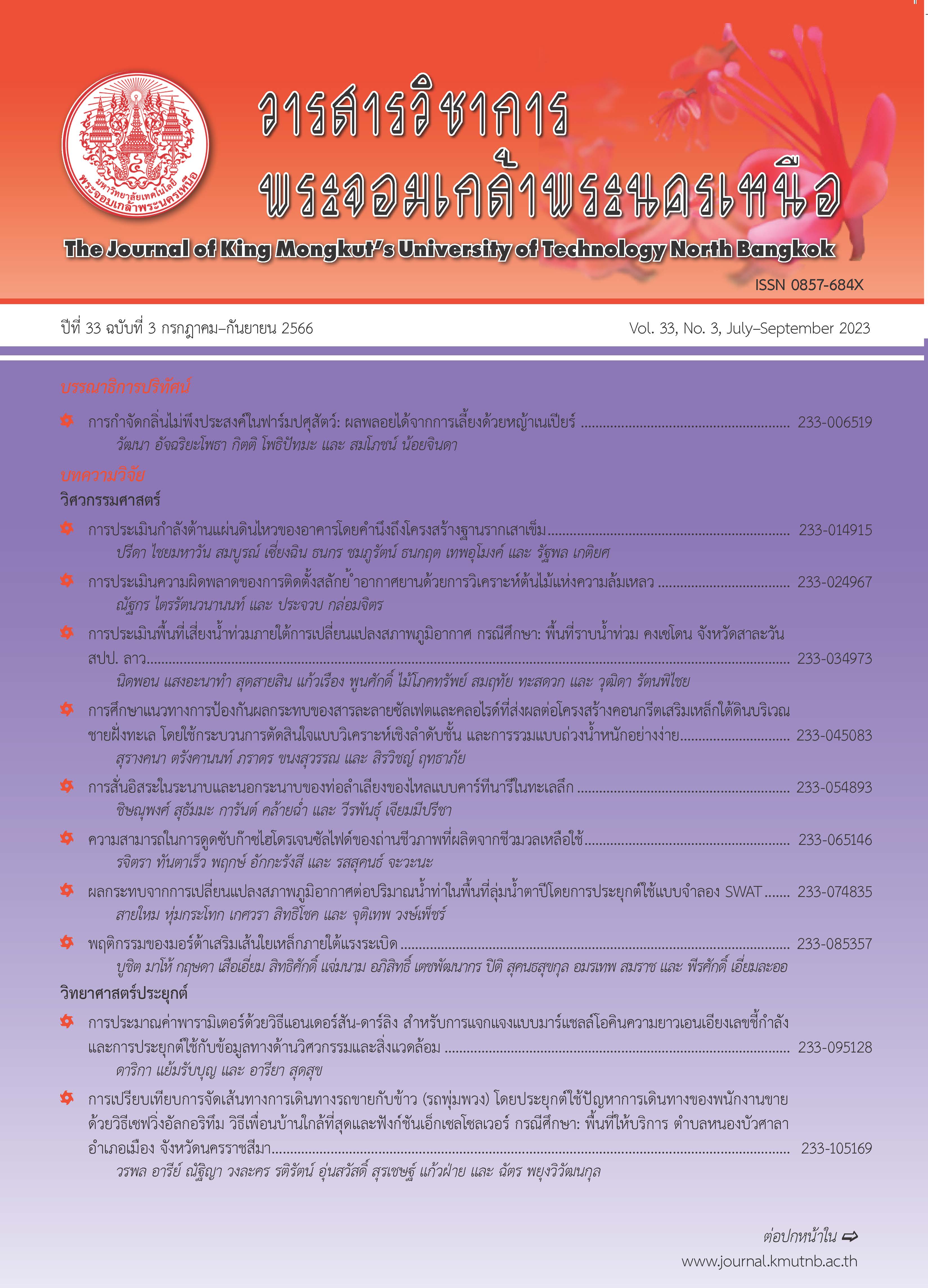การวิเคราะห์โครงสร้างทางเคมี และการคัดกรองฤทธิ์ต้านอนุมูลอิสระของสารคล้ายโปรดิจิโอซินที่ผลิตโดยแอคติโนแบคทีเรีย B7 (Streptomyces spectabilis)
Main Article Content
บทคัดย่อ
แอคติโนแบคทีเรียเป็นแบคทีเรียแกรมบวกสามารถสร้างสารเมตาบอไลท์ทุติยภูมิที่มีฤทธิ์ทางชีวภาพที่หลากหลายในงานวิจัยนี้มีวัตถุประสงค์เพื่อศึกษาประสิทธิภาพการสกัด การแยก และพิสูจน์โครงสร้างทางเคมีของสารสีชมพูที่แยกได้จากแอคติโนแบคทีเรีย B7 (Streptomyces spectabilis) ซึ่งเป็นเชื้อที่คัดแยกได้จากดินรังมด จังหวัดเพชรบูรณ์ ในเชื้อชนิดนี้มีรายงานสารกลุ่มโปรดิจินิน ซึ่งสารกลุ่มนี้มีฤทธิ์ต้านอนุมูลอิสระ จุลชีพ และเชื้อรา จึงมีการประเมินประสิทธิภาพเบื้องต้นในการออกฤทธิ์ต้านอนุมูลอิสระเพื่อเป็นข้อมูลในการนำไปใช้ประโยชน์ในอนาคต เช่น ส่วนประกอบในเครื่องสำอาง ผลการทดลองพบว่า เมทานอลเป็นตัวทำละลายสำหรับการสกัดที่มีประสิทธิภาพสูงสุดได้รับการตรวจสอบปริมาณสารจากน้ำหนักและโดยใช้เทคนิค HPLC สารสีชมพูบริสุทธิ์ที่แยกได้จากเทคนิคคอลัมน์โครมาโตกราฟี มีการพิสูจน์โครงสร้างสารบริสุทธิ์
ที่แยกได้โดยใช้สเปกโทรสโกปีและเทียบกับข้อมูลที่ได้มีการรายงานพบว่า สารบริสุทธิ์สีชมพูที่แยกได้มีข้อมูลตรงกับโครงสร้างของสาร 4'-Methoxy-5'-[(1"-nonyl-5"-propyl-4"-cycle-1-penten-3"-imino)-methyl]-2,2'-bi-1H-pyrrole ซึ่งจากการตรวจสอบในฐานข้อมูลพบว่า สารชนิดนี้ยังไม่มีการรายงานในเชื้อ S. spectabilis สำหรับผลการแสดงฤทธิ์ต้านอนุมูลอิสระของสารเบื้องต้นด้วยเทคนิค DPPH Radical Scavenging พบว่า สารกลุ่มที่มีสีชมพู แสดงผลการยับยั้งที่ร้อยละ 127.80 ± 0.02 (สารสกัดหยาบมีเปอร์เซ็นต์การยับยั้ง 87.85 ± 0.01%, 1.0 มก./ มล.)
Article Details

อนุญาตภายใต้เงื่อนไข Creative Commons Attribution-NonCommercial-NoDerivatives 4.0 International License.
บทความที่ลงตีพิมพ์เป็นข้อคิดเห็นของผู้เขียนเท่านั้น
ผู้เขียนจะต้องเป็นผู้รับผิดชอบต่อผลทางกฎหมายใดๆ ที่อาจเกิดขึ้นจากบทความนั้น
เอกสารอ้างอิง
A. Lazzarini, L. Cavaletti, G. Toppo and F. Marinelli, “Rare genera of actinomycetes as potential producers of new antibiotics,” Nature Reviews Microbiology, vol. 78, pp. 399– 405, 2000.
N. R. Williamson, P. C. Fineran, T. Gristwood, F. J. Leeper, and G. P. Salmond, “The biosynthesis and regulation of bacterial prodiginines,” Nature Reviews Microbiology, vol. 4, no. 12, pp. 887–899, 2006.
L. I. Meng xi, H. B. Huang, J. Y. Long, C. A. O. Jing Xiao, and Z. W. Zhang, “Antibacterial performance of a Streptomyces spectabilis strain producing metacycloprodigiosin,” Current Microbiology, vol. 78, pp. 2569–2576, 2021.
N. R. Williamson, P. C. Fineran, T. Gristwood, F. J. Leeper, and G. P. Salmond, “The biosynthesis and regulation of bacterial prodiginines,” Nature Reviews Microbiology, vol. 4, no. 12, pp. 887–899, 2006.
A. H. Faraag, A. I. El-Batal, and H. H. El-Hendawy, “Characterization of prodigiosin produced by Serratia marcescens strain isolated from irrigation water in Egypt,” Nature and Science, vol. 15, no. 5, pp. 55–68, 2017.
M. Assia, A. Hasnaa, M. Sara, M. Jamal, and M. Mohammed, “Physico-chemical characterization of a pink red-like pigments produced by five new bacterial soil strains identified as Streptomyces coelicoflavus,” American Journal of Microbiological Research, vol. 6, no. 3, pp. 67–72, 2018.
T. Kawasaki, F. Sakurai, and Y. Hayakawa, “A Prodigiosin from the Roseophilin Producer Streptomyces griseoviridis,” Journal of Natural Products, vol. 71, pp. 1265–1267, 2008.
D. Kim, J. S. Lee, Y. K. Park, J. F. Kim, H. Jeong, T. K. Oh, B. S. Kim, and C. H. Lee, “Biosynthesis of antibiotic prodiginines in the marine bacterium Hahella chejuensis KCTC 2396”, Journal of Applied Microbiology, vol. 102, pp. 937–944, 2007.
N. Starič, T. Danevčič, and D. Stopar, “Vibrio sp. DSM 14379 pigment production-a competitive advantage in the environment,” Microbial Ecology, vol. 60, pp. 592–598, 2010.
V. L. Yu, “Serratia marcescens - historical perspective and clinical Review,” New England Journal of Medicine, vol. 300, no. 16, pp. 887 893, 1979.
N. R. Williamson, P. C. Fineran, T. Gristwood, S. R. Chawrai, F. J. Leeper, and G. P. Salmond, “Anticancer and immunosuppressive properties of bacterial prodiginines,” Future Microbiol, vol. 2, no. 6, pp. 605–618, 2007.
K. V. Arivizhivendhan, M. Mahesh, R. Boopathy, S. Swarnalatha, R. Regina Mary, and G. Sekaran, “Antioxidant and antimicrobial activity of bioactive prodigiosin produces from Serratia marcescens using agricultural waste as a substrate,” The Journal of Food Science and Technology, vol. 55, no.7, pp. 2661–2670, 2018.
E. Hacene, “Effect of prodigiosin from Serratia marcesccens BR1 strain as an antioxidant, antimicrobial, and in vivo wound healing,” Asian Journal of Pharmaceutical and Clinical Research, vol. 13, no. 10, pp. 175–179, 2020.
G. Berg, “Diversity of antifungal and plantassociated Serratia plymuthica strains,” Journal of Applied Microbiology, vol. 88, pp. 952–960, 2000.
S. S. Habash, H. U. C. Brass, A. S. Klein, D. P. Klebl, T. M. Weber, T. Classen, J. Pietruszka, F. M. W. Grundler, and A. S. S. Schleker, “Novel prodiginine derivatives demonstrate bioactivities on plants, nematodes, and fungi,” Frontiers in Plant Science, vol. 11, pp. 1–11, 2020.
A. J. Castro, “Antimalarial activity of prodigiosin,” Nature, vol. 213, no. 5079, pp. 903–904, 1967.
C. K. Venil and P. Lakshmanaperumalsamy, “An insight overview on microbial pigment, prodigiosin,” Electronic Journal of Biology, vol. 5, no. 3, pp. 49–61, 2009.
A. L. Staley and K. L. Rinehart, “Ectomycins, new antibacterial compounds produced by Streptomyces spectabilis: Isolation, structures, and biosynthesis,” The Journal of Antibiotics, vol. 47, no. 12, pp. 1425–1433, 1994.
Z. K. Guoa, R. Wang, F. X. Chen, T. M. Liu, M. Q. Yang, “Bioactive aromatic metabolites from the sea urchin-derived actinomycete Streptomyces spectabilis Strain HDa1,” Phytochemistry Letters, vol. 25, pp. 132–135, 2018.
N. Thurnkul and N. Huanratuek, “Isolation of actinomycetes from termite mound in srisatchanalai district sukhothai province for sillk fiber dyeing,” PSRU Journal of Science and Technology, vol, 2, no. 3, pp. 1–8, 2017 (in Thai).
A. Braca, C. Sortino, M. Politi, I. Morelli, and J. Mendez, “Antioxidant activity of flavonoids from licania licaniaeflora,” Journal of Ethnopharmacology, vol. 79, no. 3, pp. 379–381, 2002.
A. M. M. P. Valente, E. F. Boffo, and A. G. Ferreira. “Complete NMR assignments of a new prodigiosin isolated from Streptomyces violaccusniger violaccusniger,” Annals of Magnetic Resonance, vol. 7, no. 2/3, pp. 44–54, 2008.
S .K. Holkar, D. N. Begde, N. A. Nashikkar, T. A. Kadam, and A. A. Upadhyay, “Optimization of some culture conditions for improved biomass and antibiotic production by Streptomyces Spectabilis Isolated from soil,” International Journal of Pharmaceutical Sciences and Research, vol. 4, no. 8, pp. 2980–2987, 2013.
N. N. Gerber, “Prodigiosin-like pigments from Actinomadura (Nocardia) pelletieri and Actinomadura Madurae,” Applied Microbiology, vol. 18, no. 1, pp. 1–3, 1969.
J. C. L. Lapenda, V. P. Alves, M. L. Adam, M. D. Rodrigues, and S. C. Nascimento, “Cytotoxic effect of prodigiosin, natural red pigment, isolated from Serratia marcescens UFPEDA 398,” Indian J Microbiol, vol. 60, no. 2, pp. 182–195, 2020.

